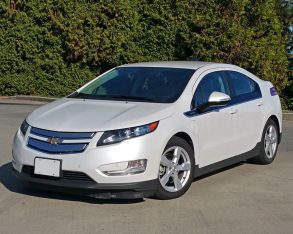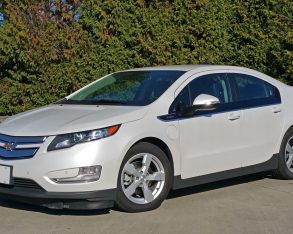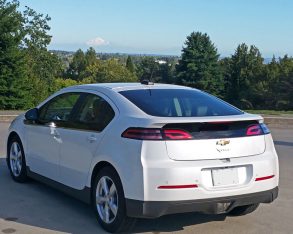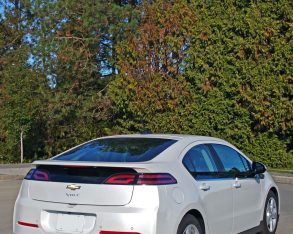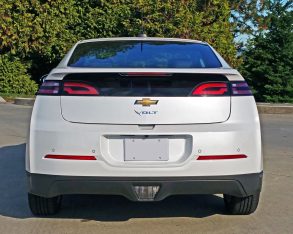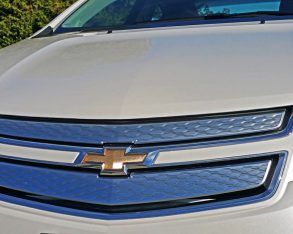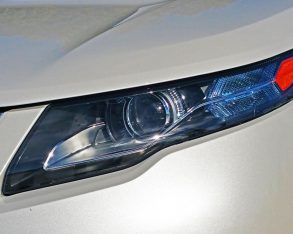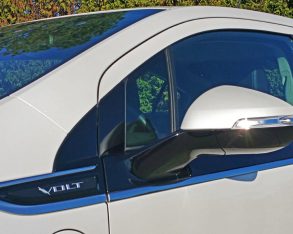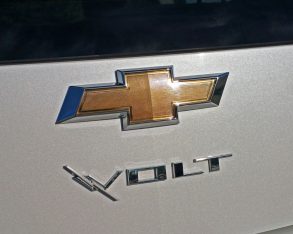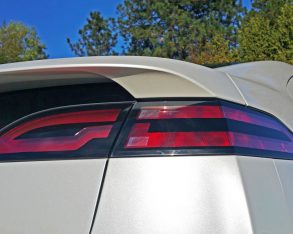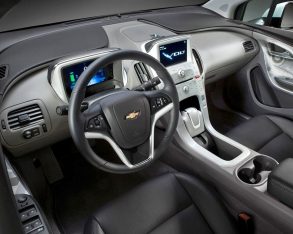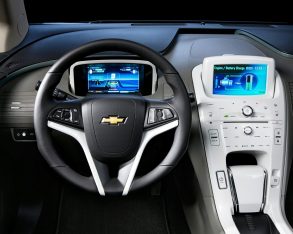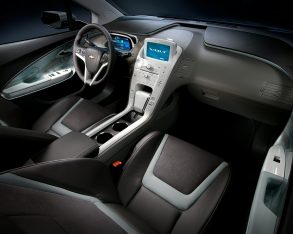 |
| Photo: Trevor Hofmann, Canadian Auto Press |
In fact, this outgoing model is even more uniquely penned than the incoming one, or at least it looks much different than the 2015 Cruze it shares much of its underpinnings with, whereas the new Volt and upcoming 2016 Cruze have had a stylistic coming together, especially when viewed from the front quarter.
The 2015 Volt’s patterned metallic grille inserts offer a nice take on Chevy’s usual bisected body-colour design, while attractively shaped headlamp clusters still look fresh after all these years, not to mention the hook-shaped DRL/fog combinations below these, which deliver some visual drama to the design. Continuing rearward, the thick black shadow line under the greenhouse remains a thoroughly unique element that no one else has even tried to copy, melds into the Volt’s unorthodox rear
 |
| Photo: Trevor Hofmann, Canadian Auto Press |
Now that I think of it, the Volt should really be the official car of Star Wars: The Force Awakens, especially when done out in stormtrooper white like my tester. It carries the Galactic Empire theme into the cabin too, with additional white detailing on the steering wheel spokes, around the primary instrument binnacle, and over to the all-white centre stack that could even make a classic Apple fan cringe from overkill. Yes, this is where the soon to be discontinued Volt looks dated,
 |
| Photo: Trevor Hofmann, Canadian Auto Press |
Yes, there are enough high-resolution displays and brightly coloured buttons to make R2-D2 feel inadequate and plenty of features to keep C-3PO busy fidgeting. I wouldn’t call the setup of touch sensitive controls nor the infotainment display particularly intuitive to use, others within GM’s lineup easier to figure out, especially
 |
| Photo: Trevor Hofmann, Canadian Auto Press |
The Volt Concept first arrived on the scene in the first month of 2007 at the Detroit auto show, with an early Voltec powertrain design in place and a promise to
 |
| Photo: Trevor Hofmann, Canadian Auto Press |
We tested every example we could get our hands on, with three of our writers covering the car on road and track from February through June of 2011, and we’ve
 |
| Photo: Trevor Hofmann, Canadian Auto Press |
I dubbed it a reverse hybrid, because the majority of motive power came from the electric motor instead of the gasoline mill, the latter used primarily for recharging the battery and providing extra oomph off the line or while traveling at highway speed. Like many who hadn’t experienced pure electric cars at that point, the idea of
 |
| Photo: Trevor Hofmann, Canadian Auto Press |
Where the Volt shines, even after four years of plug-in hybrid leadership, is in how effectively it takes care of real-world automotive duties. Where BMW, for instance, offers a wonderful city car in its perky little i3, its optional range extender engine was never intended for anything other than limping you over to the nearest charge station, whereas the Volt works as a real compact car no matter how far you’re traveling. Granted, its pure electric range is not as generous as the i3s or any
 |
| Photo: Trevor Hofmann, Canadian Auto Press |
 |
| Photo: Trevor Hofmann, Canadian Auto Press |
Depending on how you drive 68 km can last quite a while, although some will bypass this distance in a single day’s commute, so you’ll need to figure out how much you’ll save based on your own requirements. Of course, the Volt acts like a fuel-efficient hybrid even when depleted of full EV power, using idle stop/start to minimize the engine’s use when in hybrid mode and brake regeneration to resupply to the battery so it can assist that engine when needed.
When
 |
| Photo: Trevor Hofmann, Canadian Auto Press |
Whether fully charged or running in hybrid mode the Volt drives like most other cars, other than near silent operation in all-electric mode. Its electric drive motor/generator motor combination puts out 149 horsepower while its 1.4-litre four-cylinder engine will boost that when needed, although the electric’s 273 lb-ft of immediate torque won’t need any assistance, the little gasoline mill only producing 83 additional lb-ft as it is. From the seat of the pants the Volt delivers smile-inducing acceleration, while I certainly can’t complain about how it handles. The ride isn’t Chevy’s smoothest, but comfortable enough, as were its seats, while its pleasantly quiet most of the time.
That
 |
| Photo: GM |
I’ve compared the Volt to the i3 a number of times in this review, mostly because it’s one of a handful of plug-in electrics with a range extender, although the i3 takes the electric portion of the equation to much greater lengths, and vice versa for
 |
| Photo: GM |
Like with any new car, it’s always about compromise. While the Volt handles quite well for a compact car, as mentioned, the i3 reacts like your average BMW and the Prius
 |
| Photo: GM |
After everything is said and done, however, the big clincher is how much you, the EV buyer, like it, and this can only be quantified when stacking it up against its peers on the sales charts. Does Chevy sell more Volts than BMW sells i3s, or Toyota purveys Prius Plug-ins, or any other plug-in hybrid for that matter? Porsche’s plug-ins are somewhat pricier so they don’t sell as many, whereas the Honda Accord Plug-in has never been sold in Canada, although I tested it and was duly impressed. Hyundai has just introduced a new 2016 Sonata Plug-in Hybrid, however, so it’s too early to count sales numbers. This model will go head-to-head with the Ford Fusion Energi, although it could also steal sales away from the Prius Plug-in as well as the similarly designed Ford C-Max Energi. So far, however, the Volt and its Euro-only Opel Ampera cousin are
 |
| Photo: GM |
This must be exciting for GM, although they’re only too aware of the onslaught of plug-in hybrids that have arrived since the Volt made the majority of those sales (it enjoyed its biggest year ever in Canada last year with 1,521 sales and has managed 1,071 units for the 2015 calendar year-to-date as of October, although sales in the US have been tapering off substantially since eclipsing the 23k mark in 2012 and 2013, with last year’s total only 18,805 and this year’s YTD sales a mere 11,299 as of October), while yet more competitors are slated to arrive in the coming months and years. What’s more, despite overall range limitations there’s been a rise in pure EV sales too, with Nissan’s Leaf, for instance, hitting the 100,000-unit mark in January of 2014 and passing 150,000 deliveries just a year later in January of 2015.
Still,
 |
| Photo: GM |
You want to know the best part? If this outgoing model meets your commuting requirements Chevy will give you a $3,442 discount off of its $38,395 base price without even asking, and that’s before any of the provincial government rebates that Ontarians, Quebecois and British Columbians enjoy. Such a car wouldn’t include my tester’s $1,135 Iridescent Pearl Tricoat paint, mind you, although the Volt looks good in its other colours, while my tester’s nav system added $795 to the tally, pretty reasonable I’d say. Its leather upholstery with suede-like inserts and removable rear armrest added another $1,210, while GM also tossed in a rearview camera, rear parking sonar and an auto-dimming rearview mirror for $705, plus front parking sonar,
 |
| Photo: GM |
Worth it? Well that’s up to you, of course, but like I mentioned a moment ago, more than 100,000 owners can’t be wrong. I have to agree. While $40+k might be a lot to spend for a compact four-door hatch, there are a lot of Audi A4, BMW 3 Series, Mercedes-Benz C-Class and Cadillac ATS buyers who won’t blink an eye at spending tens of thousands more, and none of those cars offer the cutting edge cool factor of being able to plug in, nor the ability to drive solely on electric power more often than not. That, my friends, is a priceless experience, especially when passing by gas stations advertising pump prices that are now about the same as they were before the price of crude dropped earlier this year, let alone to the ultra-low levels they’re at right now. Sticking it to big oil is wonderfully satisfying, I must say. Yes, I’m leaning towards a plug-in for my next new car. How about you?
©(Copyright Canadian Auto Press)




